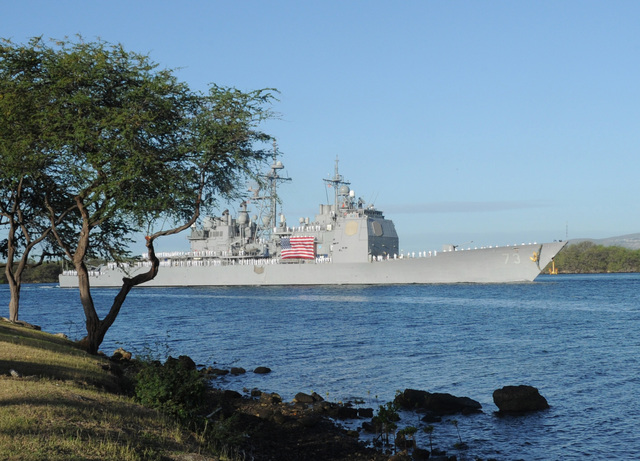Tied to a dock by budget cuts, Pearl Harbor’s USS Port Royal to return to sea

CRAIG T. KOJIMA / 2012
The guided-missile cruiser USS Port Royal returns from a deployment that included participation in the end of the Iraq War.
The Pearl Harbor-based USS Port Royal, the youngest cruiser in the Navy lineup, hasn’t been on a major deployment in four years due to Navy and congressional wrangling over tightening budgets. That has sidelined the warship, which has high-demand ballistic missile shoot-down capability.
By comparison, the USS Paul Hamilton, a destroyer out of Pearl with ballistic missile capability, deployed for seven months in 2010-11, nine months in 2012-13 and seven months in 2015.
The Port Royal’s turn for the worse began with a bad grounding incident in 2009 off Honolulu Airport’s reef runway, after which the Navy decided — incorrectly, according to the U.S. Government Accountability Office — that the ship had hidden maintenance problems and was a write-off.
The $1 billion cruiser, with a crew of more than 300, returned Feb. 13, 2012, from an almost eight-month deployment that included participation in the end of the Iraq War.
But in an effort to achieve budgetary savings following the enactment of the Budget Control Act of 2011, the Navy decided to decommission seven cruisers, the Port Royal included, the GAO said.
That plan and others by the Navy to sideline the aging cruisers failed, and the service was forced to catch up on deferred maintenance for the Port Royal and more recently plan for the cruiser’s deployment this summer, according to the service.
Don't miss out on what's happening!
Stay in touch with breaking news, as it happens, conveniently in your email inbox. It's FREE!
“Due to budgetary considerations and the uncertain programmatic future of the Ticonderoga-class cruisers, the Navy made the decision to defer maintenance on Port Royal until 2014,” Lt. Rebecca Haggard, a spokeswoman for Naval Surface Force, Pacific Fleet, in San Diego, said in a statement. “Since returning to the deployment rotation, Port Royal has completed her maintenance availability and is completing her basic and integrated training in preparation to deploy before the end of (fiscal) ‘16.”
The belated deployment comes after a complex series of Navy proposals that included the failed decommissioning plan, and then a proposal to mothball half the fleet for eventual modernization.
In March 2014 the Navy proposed the “phased modernization plan” that included placing 11 Ticonderoga-class cruisers into a reduced operating status for eventual maintenance “to reduce near-term funding requirements and as a means to extend the life of the ships,” according to the GAO.
The ships were to be minimally manned while in phased modernization for between five and 12 years and then returned to the fleet. That plan didn’t pass muster with Congress, either.
Some critics, including U.S. Rep. J. Randy Forbes (R, Va.), chairman of the House Armed Services Committee’s Seapower and Projection Forces Subcommittee, have argued vociferously for keeping the cruisers in service while the size of the Navy shrinks and the demands for missile defense grow.
“This is yet another example of how sequestration and arbitrary spending limits are having a devastating impact on our national security and on our economy,” said U.S. Rep. Tulsi Gabbard (D, Hawaii), a member of the House Armed Services Committee.
“It’s important to keep these Navy cruisers operational, especially with the North Korean missile and nuclear threat placing Hawaii squarely within its sights and within range,” she said. “These cruisers have sophisticated missile defense capabilities that are important to protect Hawaii and the nation’s military assets based here.”
Not all of the Navy’s cruisers have ballistic missile interception capability, but the Port Royal, commissioned in 1994, is among five that do. Plans call for those to be modernized to achieve even greater capability.
Pearl Harbor’s only other cruiser, the USS Chosin, is leaving Hawaii later this month for modernization in San Diego, the Navy said. The 567-foot ship has been at Pearl Harbor since 1991, the year it was commissioned.
In February 2015, the Navy, in response to congressional concerns, revised its cruiser plan to the so-called 2/4/6 scheme. The revision stated that each year no more than two cruisers would be placed in phased modernization, no cruiser would remain in modernization for more than four years and no more than six cruisers would be in modernization at the same time.
The Navy brought USS Cowpens and USS Gettysburg into modernization in fiscal 2015, and Vicksburg and Chosin will go in sometime in 2016. The 2/4/6 plan keeps more cruisers in service now, but shortens their lifespan down the road.
Modernization upgrades have already been made to the Aegis combat systems on all or most of the 11 oldest cruisers, and with the four in or heading into yards for similar work, the Navy still hasn’t given up on its desire to put the last seven — the Port Royal included — into maintenance next fiscal year.



